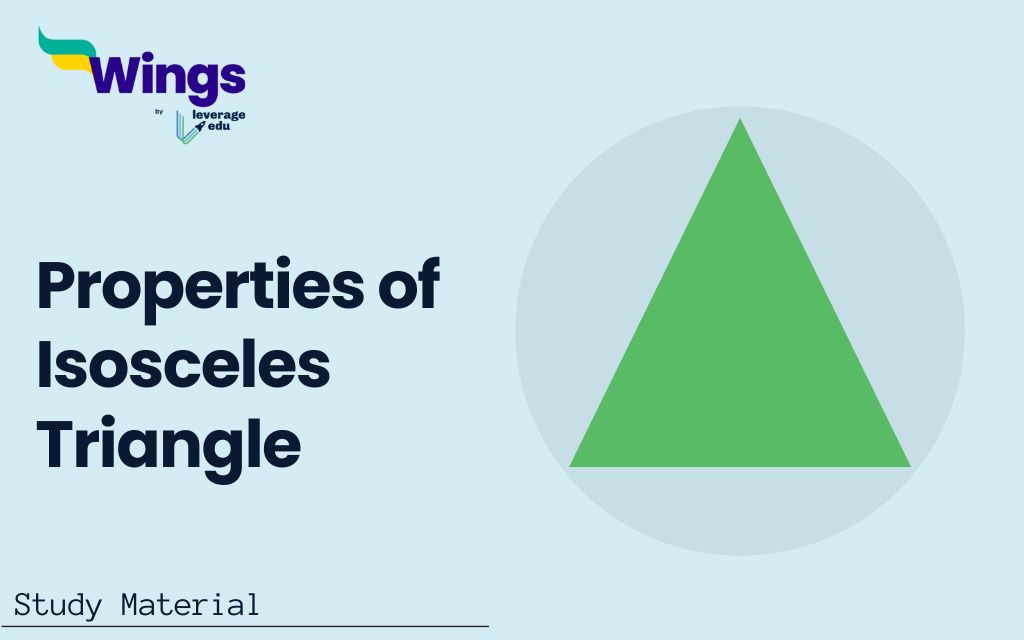An isosceles triangle is a polygon that has two equal sides, two equal angles, three edges, three vertices, and the addition of internal angles of a triangle up to 180 degrees. Basically, an isosceles triangle is a triangle that has two equal-length sides. Other than that, the third side of the triangle is unequal to the other two sides, it is called the base of the isosceles triangle. To know more about the properties of an isosceles triangle, you can read this article, till the end.
Contents
Definition of isosceles Triangle
An isosceles can be stated as a triangle that has two equal sides. Also, the two angles opposite at two equal sides are equal. Also, an isosceles triangle has two congruent sides. For example, if there is an isosceles triangle, whose angle B is equal to angle C. The theorem that defines an isosceles triangle is “if the two sides of a triangle are congruent, then the angle opposite to them are also congruent”.
Also Read: Area Of Isosceles Triangle with Solved Examples
Different Angles of Isosceles Triangle
The two sides out of the three of an isosceles triangle are equal when measured, which are opposite to the equal sides. Therefore, the remaining angle is unequal. Take an example, if the measure of an unequal angle is provided, then the other two angles can be easily found by using the angle sum property.
Acute Isosceles Triangle: In an acute isosceles triangle, the vertex angle is the smallest angle and is less than 90 degrees. The two base angles are congruent and each is greater than 90 degrees divided by two.
Right Isosceles Triangle: A right isosceles triangle is a special case where the vertex angle is exactly 90 degrees. This makes the two base angles congruent and each equal to 45 degrees. Right isosceles triangles are also squares.
Obtuse Isosceles Triangle: In an obtuse isosceles triangle, the vertex angle is the largest angle and is greater than 90 degrees. The two base angles are congruent and each is less than 90 degrees divided by two.
What are the Properties of the Isosceles Triangle?
There are different properties of the isosceles triangle, some of which are stated in the given section of the article. Have a look at the given data.
- The two sides of this triangle are equal and unequal.
- The side that’s not equal to the other two is called the base of the triangle.
- The two angles opposite the equal sides (legs) are congruent.
- If the isosceles triangle also has a right angle, then the two equal angles will each measure 45 degrees.
After exploring the properties of the Isosceles triangle, you now need to solve some mathematical problems related to the isosceles triangle. Practicing the questions will help develop a grip on the questions and solve them in a better way. Explore the questions now.
Questions to Practice on Isosceles Triangle
It is a time-consuming process to find the appropriate questions to practice on the isosceles triangle. To save you time, we have included some quality questions for you to practice and develop a better understanding of the concept. Have a look at it now.
Question 1: You are given an isosceles triangle ABC with AB = AC = 8 cm and angle B = 50 degrees. Find the measure of angle C.
Solution: In an isosceles triangle, the angles opposite the congruent sides are equal. Therefore, angle C is also equal to angle B. Thus, angle C = 50 degrees.
Question 2: An isosceles triangle DEF has DE = DF = 12 cm and EF = 6 cm. Find the perimeter of the triangle.
Solution: Perimeter of a triangle is the total length of all its sides added together. Since two sides are equal, the perimeter is: Perimeter = DE + DF + EF
Perimeter = 12 cm + 12 cm + 6 cm = 30 cm.
Question 3: In isosceles triangle PQR, PQ = PR = 10 cm and the altitude drawn from P to base QR is 6 cm. Find the area of the triangle.
Solution: Area of a triangle is 1/2 * base * height. In this case, base QR = PR + PQ = 10 cm + 10 cm = 20 cm.
Area = 1/2 * 20 cm * 6 cm = 60 cm²
Related Blogs
| Properties of Rational Numbers | Commutative Property |
| Properties of HCF and LCM | Properties of Rectangle |
| Properties of Triangle | Associative Property |
FAQs
An isosceles triangle has two sides that are equal in length. The third side is sometimes called the base.
In an isosceles triangle, the two angles opposite the equal sides are also equal to each other. These angles are called the base angles.
Yes! The vertex angle is always the opposite of the base in terms of size.
This was all about the “Properties of Isosceles Triangle”. For more such informative blogs, check out our Maths Section, or you can learn more about us by visiting our Study Material Section page.
 One app for all your study abroad needs
One app for all your study abroad needs














